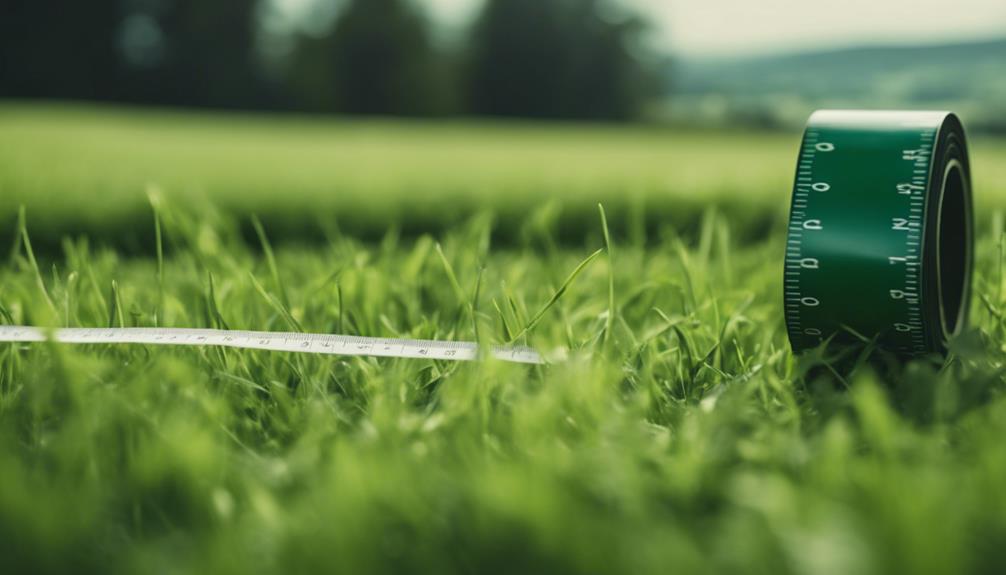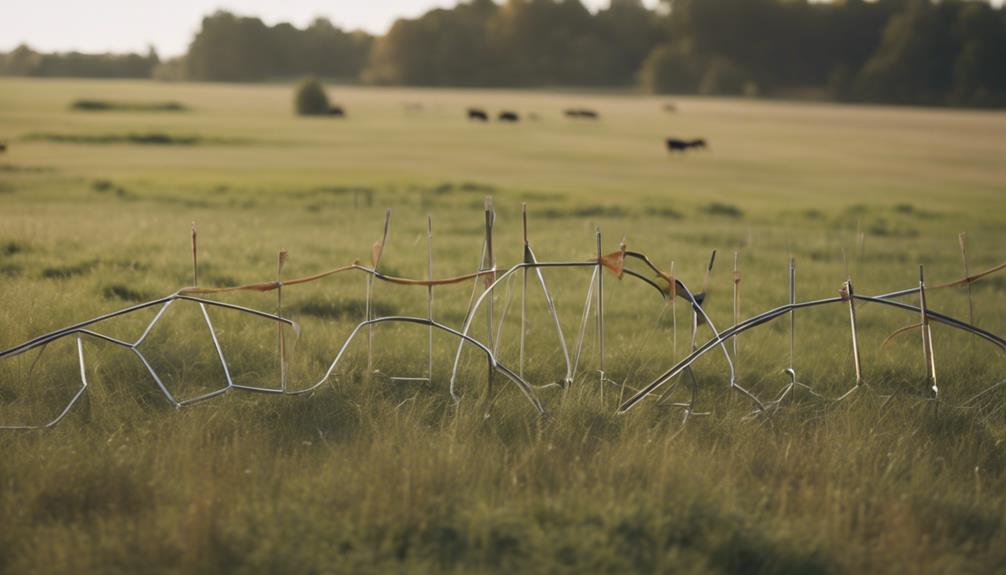To accurately calculate forage per acre, follow these steps: Determine total forage yield and acres. Use the formula F = Y / A. For example, if you have 50 tons for 25 acres, you get 2 tons/acre. Remember to record data precisely and double-check calculations. Understanding forage yield is key for land productivity. Factors such as soil fertility and grazing management impact production. By making use of forage per acre data, you can optimize resources and improve sustainable practices. Calculating forage density, measuring land area, and evaluating quality are essential. This approach enables well-informed decisions in agriculture.
Key Takeaways
- Measure land area accurately.
- Calculate total forage production.
- Determine forage density using formula.
- Assess forage quality for livestock.
- Adjust management practices based on results.
Importance of Forage Per Acre
Understanding the importance of forage per acre is essential for maximizing agricultural productivity and efficiency. By calculating the forage per acre, you can determine the carrying capacity of your land, which is the number of livestock your pasture can support sustainably.
This vital metric influences your management decisions, such as how many animals to graze, when to rotate pastures, and how to plan your feeding strategy effectively.
Monitoring forage per acre allows you to assess your land's productivity accurately and make informed choices regarding crop rotation, fertilization, and irrigation. This knowledge empowers you to optimize your resources, enhance operational efficiency, and maintain sustainable agricultural practices.
By using the formula F = Y / A (forage per acre = total forage yield / total acres), you can quantify your land's forage production and make data-driven decisions that benefit both your livestock and crop management strategies.
Maximize your land use efficiency by prioritizing the understanding of forage per acre in your agricultural endeavors.
Tools Needed for Calculation

To accurately calculate forage per acre, make sure you have the necessary tools at your disposal, including a measuring tape, forage clipper, scale, and calculator. These tools play an essential role in obtaining precise measurements and conducting accurate calculations of forage yield.
By utilizing the right tools, you can gather essential data for making informed decisions regarding land management practices. The measuring tape helps determine the dimensions of the land area under consideration, while the forage clipper is used to collect samples for analysis. A scale is necessary for weighing the forage samples, and a calculator simplifies the process of calculating the amount of forage per acre.
Having these tools on hand ensures that you can assess the productivity of your land effectively, enabling you to optimize resources and enhance operational efficiency in agricultural activities.
Step-by-Step Calculation Process

Start by determining the total forage yield in tons and the total number of acres of land you're evaluating. Once you have these figures, you can proceed with calculating the forage per acre using the formula F = Y / A, where F represents the forage per acre, Y is the total forage yield in tons, and A is the total number of acres.
For example, if your total forage yield is 50 tons and you're evaluating 25 acres of land, the calculation would be 50 / 25 = 2 tons/acre.
To guarantee accurate results and effective land management, follow these steps:
- Record the total forage yield in tons and the total number of acres of land accurately.
- Substitute the values into the formula F = Y / A to determine the forage per acre.
- Double-check your calculations to secure precision in understanding the forage productivity of your land.
Understanding Forage Yield Measurements

Understanding forage yield measurements is key to gauging the productivity of your land and ensuring peak forage production.
By accurately measuring how much forage your acreage yields, you can make informed decisions on resource allocation and livestock management.
These measurements provide essential data for maximizing agricultural efficiency and sustainability.
Forage Yield Importance
Forage yield measurements play a critical role in optimizing livestock feeding, crop management, and land productivity.
To understand the importance of forage yield, consider the following points:
- Guiding Decisions: Accurate forage yield calculations help farmers make informed decisions on stocking rates, grazing plans, and forage utilization. These decisions are vital for maintaining healthy livestock and maximizing the use of available forage resources.
- Quantifying Production: Methods like clipping, weighing, and drying samples aid in determining the amount of forage produced per acre. This quantitative data is essential for evaluating the productivity of the land and planning for sustainable agricultural practices.
- Maximizing Resources: Understanding forage yield per acre enables farmers to optimize land productivity and efficiently manage resources. By monitoring forage production, farmers can make adjustments to promote the long-term health of their livestock and the sustainability of their agricultural operations.
Measuring Forage Productivity
To effectively gauge the productivity of your forage, begin by familiarizing yourself with the methods used to measure forage yield per acre. Calculating forage per acre is vital for optimizing resources and making informed decisions in agriculture.
Methods such as clipping, weighing, and drying are employed to accurately calculate forage yield per acre. This calculation not only helps determine land productivity but also establishes the carrying capacity for livestock on the given acreage.
Understanding forage yield measurements is essential as it guides management decisions concerning both crop and livestock operations. By measuring forage productivity, you can make strategic choices that promote sustainable land use and enhance overall agricultural efficiency.
Incorporating these techniques into your agricultural practices will enable you to maximize the potential of your land while ensuring the well-being of your livestock.
Factors Affecting Forage Production

Factors affecting forage production include:
- Soil fertility impact
- Climate and weather patterns
- Grazing management strategies
Soil health, nutrient levels, and organic matter content all contribute to the success of forage crops. Understanding these key factors can help you optimize your land's productivity and enhance forage production per acre.
Soil Fertility Impact
When thinking about the impact of soil fertility on forage production, it's essential to understand how nutrient availability directly influences plant growth. Soil fertility impact on forage yield per acre can be significant.
Here are three key points to keep in mind:
- Nutrient Levels: Adequate levels of essential nutrients like nitrogen, phosphorus, and potassium are vital for maximizing forage production. Deficiencies can lead to stunted growth and reduced yields per acre.
- Soil pH: The pH level of the soil affects nutrient availability to plants. Maintaining the correct pH range ensures that plants can access the necessary nutrients for healthy growth and increased forage production.
- Organic Matter Content: Soil rich in organic matter provides a continuous source of nutrients for plants. Higher organic matter content can improve soil structure, water retention, and nutrient availability, ultimately enhancing forage yields per acre.
Balanced soil fertility through proper management practices and regular soil testing is key to maximizing forage production and quality.
Climate and Weather
Climate and weather play a significant role in determining the success of forage production by directly influencing growth rates and nutrient content. The conditions of the climate, such as temperature, precipitation, and sunlight, are pivotal factors that impact the quality and quantity of forage per acre.
Extreme weather events like droughts or floods can severely reduce forage production in a given area, leading to challenges for farmers. Understanding local climate patterns is essential for predicting forage availability and planning grazing strategies effectively.
Farmers must adapt their management practices based on seasonal weather variations to optimize forage production per acre. By monitoring and adjusting to the climate and weather conditions, farmers can better prepare for potential challenges and maximize their forage production yields.
Grazing Management Strategies
Effective grazing management directly impacts forage production by influencing the health and growth of plants.
To optimize forage yield per acre, consider the following factors:
- Stocking rate: Adjust the number of animals grazing on a particular area to prevent overgrazing, which can lead to reduced forage availability and plant regrowth.
- Rest periods: Allow adequate time for plants to recover after grazing to maintain healthy vegetation and promote continuous forage production.
- Plant species diversity: Incorporating a variety of plant species in grazing areas can enhance average forage quality and quantity, providing a more balanced diet for livestock.
Utilizing Forage Per Acre Data

To effectively utilize forage per acre data, analyze the calculated values in relation to your farming practices and livestock needs. By calculating the total forage yield and the total acres of your land, you can determine the amount of forage available per acre using the formula F = Y / A. This information is invaluable for optimizing your resources, making informed decisions about crop management, and guaranteeing that your livestock are adequately fed.
Understanding the productivity of your land through forage per acre calculations is essential for sustainable agriculture practices. It allows you to adjust your grazing management strategies, allocate resources efficiently, and plan forage production effectively. By utilizing forage per acre data, you can tailor your farming practices to meet the specific needs of your livestock while maximizing the yield from your land.
For accurate results, consider using the provided calculator to double-check your calculations and ensure that you're making the most of your land based on forage per acre data.
Practical Applications in Agriculture

Applying forage per acre calculations can revolutionize your agricultural practices, enhancing efficiency and sustainability. By utilizing the formula F = Y / A, you can optimize your resources and make informed decisions to improve operational efficiency.
Here are three practical applications in agriculture that highlight the importance of understanding forage per acre, total forage yield, and land productivity:
- Evaluating Land Productivity: Calculating forage per acre helps you evaluate the productivity of your land. This evaluation guides your crop management strategies, allowing you to maximize the yield from your available acreage.
- Planning Livestock Feeding: Understanding the total forage yield per acre enables you to plan your livestock feeding schedules effectively. By knowing how much forage is available, you can make sure that your animals receive the necessary nutrition for their well-being.
- Determining Land Use Strategies: Accurate calculations of forage per acre assist in determining the best land use strategies for sustainable agricultural practices. This information helps you make informed decisions on how to utilize your land efficiently while promoting long-term sustainability.
Enhancing Grazing Management Practices

To enhance your grazing management practices, consider implementing grazing rotation benefits. By rotating pastures strategically, you can promote better forage regrowth and prevent overgrazing.
Managing forage quality effectively is also crucial. Monitoring forage quality guarantees that your livestock receive the necessary nutrients for peak health and performance.
Additionally, utilizing grazing charts can be beneficial for best results. These charts help in planning and organizing grazing activities efficiently.
Grazing Rotation Benefits
Enhancing grazing management practices through effective grazing rotation can greatly boost forage quality and quantity on your pastures.
- Increased Forage Yield: By allowing pastures to rest and regenerate through rotational grazing, you can improve the overall forage yield per acre. This means more food for your livestock without compromising the health of your pastures.
- Maximized Dry Matter: Proper grazing management practices result in a balanced distribution of average dry matter per acre. This ensures that your livestock have access to high-quality forage consistently, promoting better growth and performance.
- Enhanced Pasture Health: Grazing rotation benefits extend beyond quantity and quality of forage. It also leads to healthier pastures by reducing soil erosion, improving nutrient distribution, and promoting overall pasture vitality.
Implementing grazing rotations not only boosts productivity and efficiency but also contributes to sustainable land management practices, benefiting both your livestock and the environment.
Forage Quality Management
Improve your grazing management practices by focusing on forage quality management techniques to guarantee peak livestock nutrition and pasture health. Managing the amount of forage dry matter consumed by your livestock is essential for maintaining their health and maximizing productivity. By monitoring forage quality regularly, you can make certain that your animals are receiving the necessary nutrients for peak growth and performance. Leaving adequate residue in grazing areas is critical for preserving ground cover and supporting plant regrowth, promoting a sustainable grazing environment.
To help you understand the importance of forage quality management, here's a table illustrating the impact of the pounds of dry matter consumed by livestock on their nutrition and overall well-being:
| Pounds of Dry Matter Consumed | Impact on Livestock Nutrition |
|---|---|
| Less than recommended amount | Nutrient deficiencies |
| Recommended amount | Peak growth and health |
| Excessive amount | Wastage and potential health issues |
Utilizing Grazing Charts
Grazing charts play a crucial role in optimizing livestock feeding and land utilization for enhanced grazing management practices. By utilizing grazing charts, you can efficiently calculate forage per acre and make informed decisions regarding your pasture management.
Here are three key benefits of incorporating grazing charts into your farming practices:
- Accurate Forage Availability: Grazing charts provide critical information on the amount of forage available per acre, enabling you to plan your livestock feeding schedule effectively.
- Informed Grazing Management: These charts help you make informed decisions about when and where to graze your animals, ensuring efficient land utilization and pasture health.
- Enhanced Efficiency: By understanding how to interpret and utilize grazing charts, you can optimize your grazing practices to improve animal performance, leading to sustainable agriculture practices.
Incorporating grazing charts into your farming routine can greatly enhance your overall grazing management practices, ultimately benefiting both your livestock and land health.
Monitoring and Adjusting Forage Levels

To effectively manage your forage levels, start by regularly measuring and tracking the amount of forage produced per acre. Calculating the forage per acre allows you to make informed decisions when adjusting your livestock feeding, land use, and overall farm productivity.
By monitoring and adjusting forage levels, you can optimize your crop management and grazing strategies.
Monitoring forage levels is vital for maintaining sustainable agriculture practices and ensuring adequate nutrition for your livestock. Utilizing the forage per acre formula helps you assess your land productivity accurately and make necessary adjustments for efficient resource management.
Keep a close eye on your forage levels to guarantee that your livestock have enough high-quality feed while maximizing the productivity of your land.
Maximizing Land Productivity

Begin by evaluating the current management practices on your land to identify opportunities for enhancing land productivity. To maximize land productivity effectively, consider the following:
- Analyze Your Yield Per Acre:
Assess the current yield of forage per acre on your land to determine the pivotal starting point for improving overall productivity. This information serves as an essential starting point for enhancing overall productivity.
- Optimize Total Forage Production:
Evaluate ways to increase the total forage yield while maintaining sustainable agricultural practices. Efficiently utilizing land resources can greatly enhance productivity levels.
- Implement Data-Driven Decisions:
Utilize accurate calculations for forage per acre to make informed decisions regarding land management. By relying on data-driven insights, you can effectively maximize land productivity and ensure long-term sustainability.
Frequently Asked Questions
How Do You Calculate Forage per Acre?
To calculate forage per acre, divide the total forage yield by the total acres. This formula, F = Y / A, helps assess land productivity. Utilize the provided calculator to verify your calculations for efficient land management.
What Is the Formula for Forage Consumption?
To calculate forage consumption, divide the total forage yield by the total acres. This formula, F = Y / A, helps you determine the amount of forage per acre, aiding in resource optimization and informed agricultural decisions.
How Much Forage Is Produced per Acre?
In your fields, each acre yields a bounty of forage. Embrace the equation F = Y / A to reveal the exact amount of hay or silage produced per acre. Let this wisdom guide your agricultural endeavors.
How Do You Calculate Forage Demand?
To calculate forage demand, determine daily intake per animal in pounds, then multiply by the number of animals. This total gives the forage demand per day. Knowing this helps manage grazing sustainably and prevent overgrazing.
Conclusion
So there you have it – the ingenious formula to calculate exactly how much forage per acre.
With the right tools and a step-by-step process, you can accurately measure and manage your land's productivity.
Keep in mind the factors that affect forage production, and remember, the sky's the limit when it comes to maximizing your land's potential.
Happy calculating!










